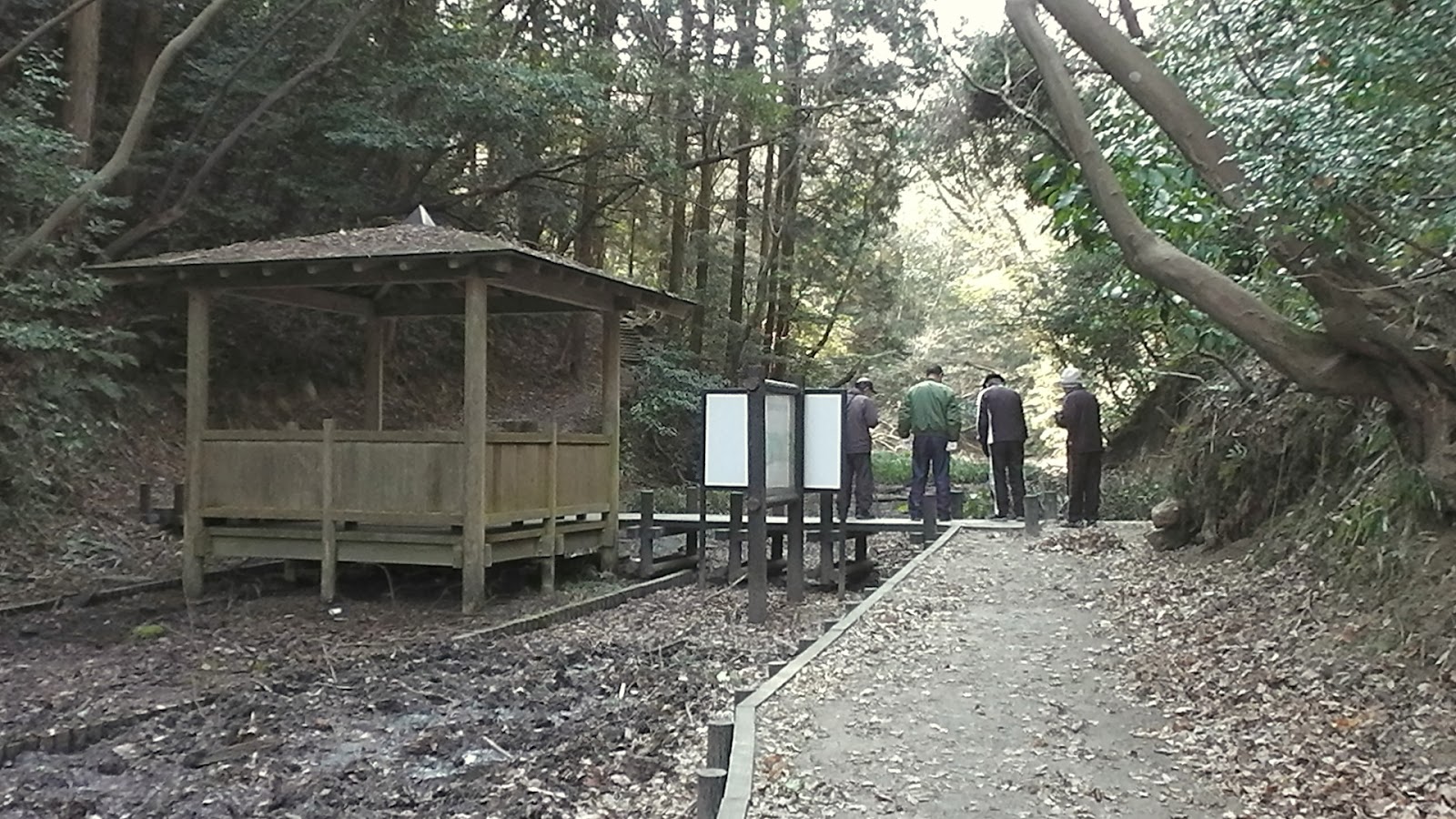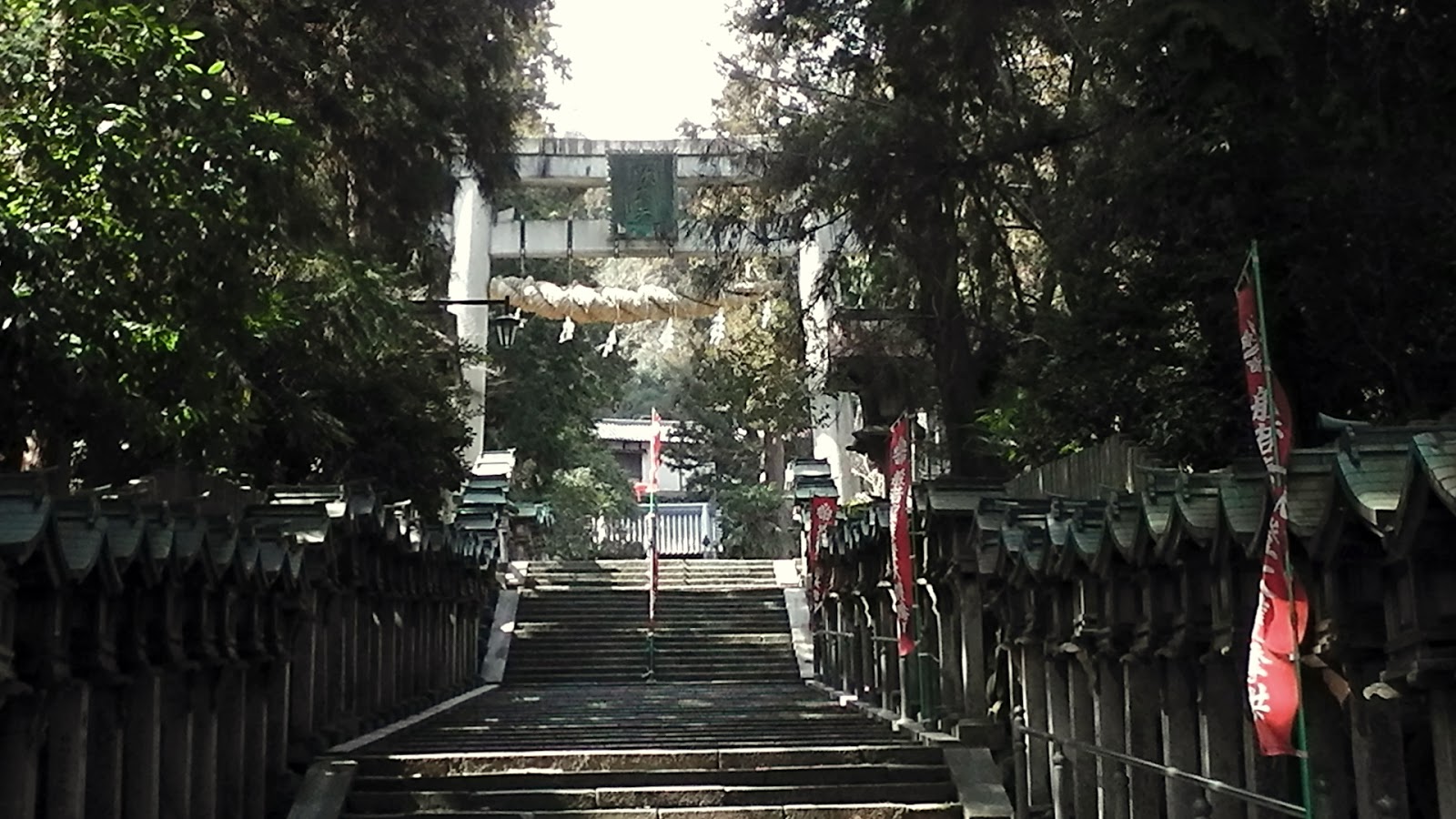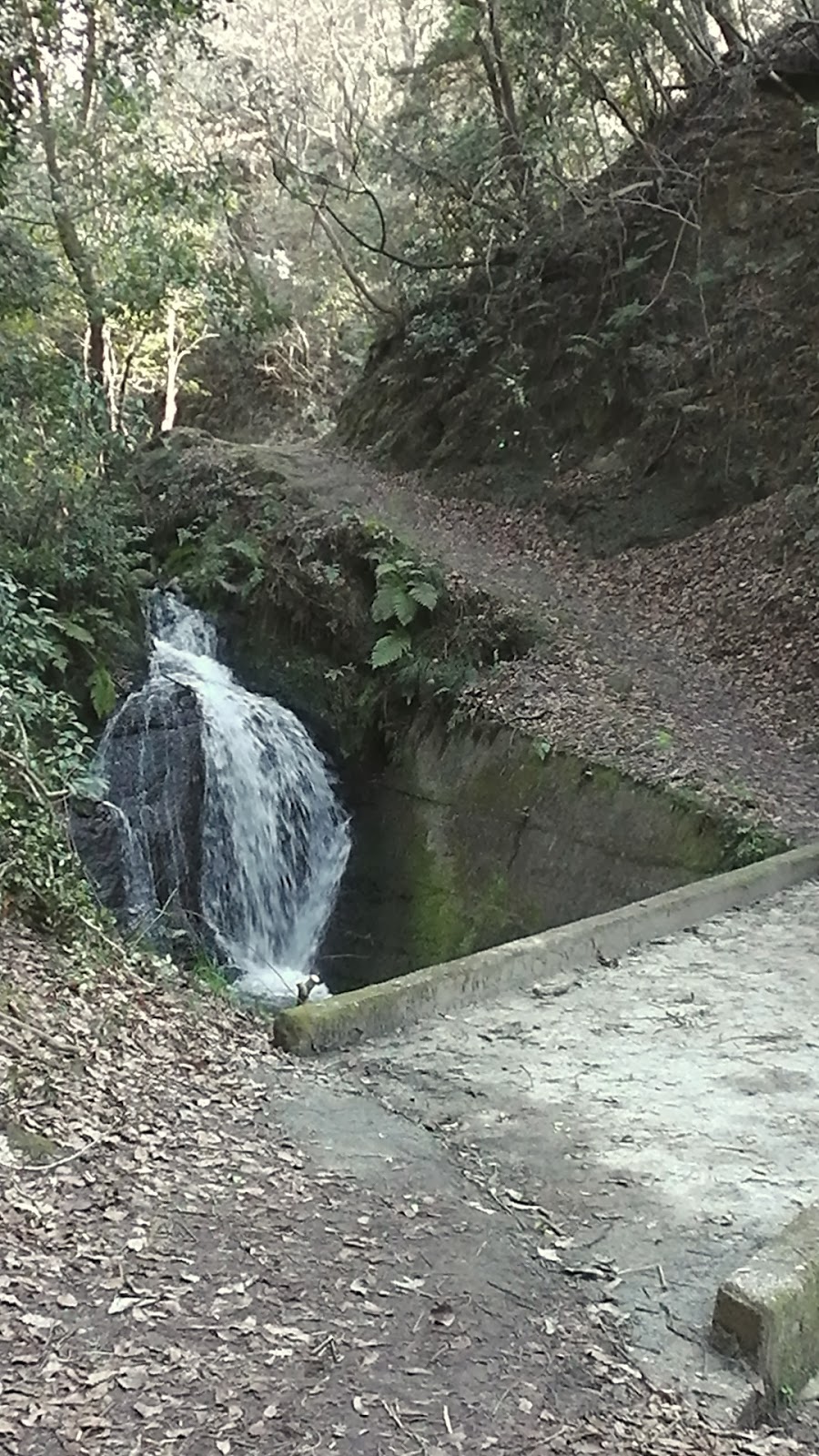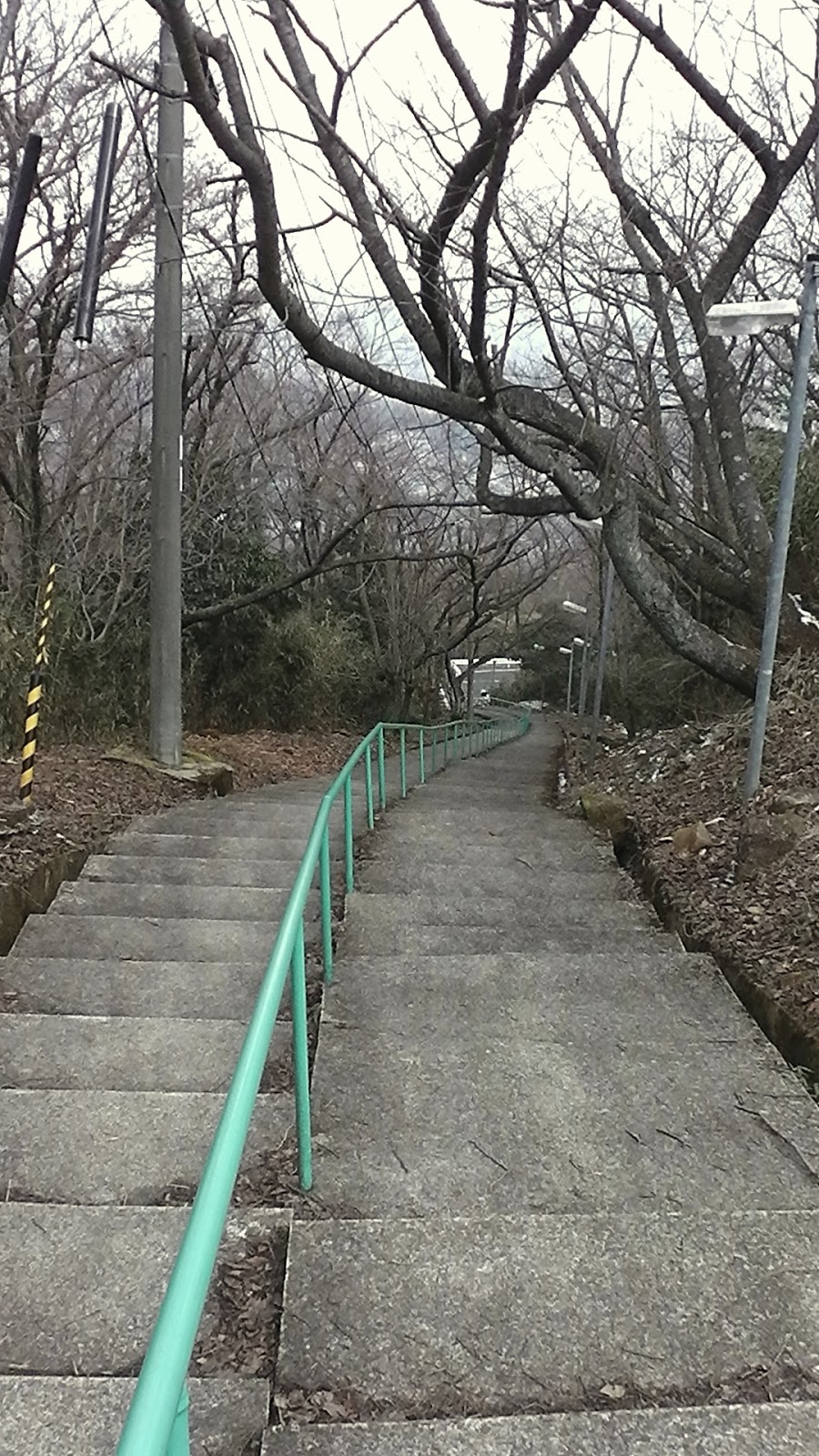This course comprises of four tracks that, in two instances, run in conjunction, or on the same stretch, albeit for about 50-meters. Having been in this area many times over the years, I was aware of the scenery in store for me but, my main reason were the several Temples and Shrines located along my course (if you hadn't guessed by now, I have a strong interest in these complexes).
 |
| Map Location. |
But, on this occasion I was taking the lane on my left through a compacted residential area. This map helped confirm my route and, as I navigated my way through the maze of narrow lanes, being helped along my way with a series if signposts, to my first religious complex, . . . .
 |
| Map Location. |
Soon after leaving the shrine the conditions began to change, thanks to the forest shelter, and became cooler. My path ran parallel to a stream that I would stay with until I reached the reservoir at the Midori-no Bunkoen Park. I couldn't resist the temptation to take a photo of this vending machine and seat and, as I did so, I was reminded of an interesting statistic I heard recently: Japan, a population of over 127-million, where there is one vending machine per 23-people.
The scenery, as I made my way up the valley, is a mixture of bridges, religious icons, rest-stops and my favorite - the sounds of nature. I was in my element.
 |
| Set of Jizo. |
 By now the track was becoming busy with other hikers -this is a very popular area for fellow outdoorholics, most being social hikers just out for a days stroll through the forest and surrounding area. There is a large network of tracks through here with plenty of options for locals to explore. Shortly after leaving this site, I exit the forest and arrive at route-8 (the Shijonawate to Ikoma Road) where I cross, via a pedestrian bridge, and head in the direction of Mt Ikomayama.
By now the track was becoming busy with other hikers -this is a very popular area for fellow outdoorholics, most being social hikers just out for a days stroll through the forest and surrounding area. There is a large network of tracks through here with plenty of options for locals to explore. Shortly after leaving this site, I exit the forest and arrive at route-8 (the Shijonawate to Ikoma Road) where I cross, via a pedestrian bridge, and head in the direction of Mt Ikomayama.  |
| Map Location. |
 |
| Map Location. |
As-well-as the many paths circumnavigating the temple grounds, like this avenue of Religious Icons. This path takes you to the summit of the complex offering fine views of the grounds below.
Hozan-ji is located at the junction of two tracks, of the Ikoma-sanke Hiking Course plus, with the summit of Ikomayama not far away, the area can be very busy with members of the local hiking community. Which brings me to my next destination, the summit of Ikomayama.
There are two options to reaching the summit, via the path, or the more leisurely way, via the cable-car. I decided to walk and save myself the 280-yen (which was used to buy 2-cans of beer at the end of the day). It is a moderately steep climb but, if you take it easy, can be achieved in about 30-minutes. Reaching the summit of a mountain can be an exhilarating experience and, as this was my first visit to Ikomayama, I was looking forward to the occasion. But, it was not to be, as this video will show. Needless-to-say, I didn't stay round long.
From here my next destination was the Kuragari Pass. To get here I had to ascend down a very-muddy (thanks to the snow of the previous weeks) and steep track. Here I was to join track-10 which I would follow until the conclusion of my day, at the Kintatsu Ishikiri Station. The area is also popular with hikers as it lies at the junction of four tracks. To this point I had been hiking for about 5-hours and, as it had been some 7-hours since I had a bite-to-eat, I was beginning to look for a suitable spot to break for lunch.
And, what better location than Jiko-ji Temple. Jiko-ji, the penultimate religious complex of my day, was the perfect site - located within a forest, surrounded by the sights & sounds of nature - to dine and check my map. My access to this site was via a lane that branched-off my main path but, during my time here, a party of hikers emerged from the forest and, after a quick look-around, moved on, via another track into the forest. This has got my curiosity-juices running and, as I compose this, am already planning my return.
 From here my path skirted-around the western base of Ikomayama to this junction - the Ikoma Nature Walk and the Zushidani Hiking Course - and my descent down a path that has quite a history attached to it. From as far back as 815AD, such notables as the Buddhist Monk Koubou Daishi, trained in this area.
From here my path skirted-around the western base of Ikomayama to this junction - the Ikoma Nature Walk and the Zushidani Hiking Course - and my descent down a path that has quite a history attached to it. From as far back as 815AD, such notables as the Buddhist Monk Koubou Daishi, trained in this area.
Five Hundred meters into my descent, I turn a corner, and am greeted with this concrete Torii, heralding my arrival at . . . .
. . . . Kouhou-ji Temple. The temple was established here during the Jomei Period (629 -641), but the present temple was built around 1360. As I arrived it commenced snowing, which added to the atmosphere of the area. It's a compacted site, with not much distance between buildings. As I wondered around, I tried to imagine what it was like 1,300-years ago and how the complex was constructed - no trucks, no bulldozers, no cranes - and marvelled at the sheer willpower of those responsible for constructing this temple.
The final 2km of my path was like walking through a corridor if religious Icons. And, with the snow still falling, I was treated to some awesome scenery. As seen in this video.
Upon my arrival at the Ishikiri Station, a noticeboard, with map, alerted me to attractions in the area. Viewing it, I realized I had missed a lot of sites during my descent. Which was my cue to make the comment - "I'll be back".
This is the full video of my days outing.
This is the full course , courtesy of
Ride With G.P.S.
 |
| Map Location. |
 |
| Map Location. |
 From here my path skirted-around the western base of Ikomayama to this junction - the Ikoma Nature Walk and the Zushidani Hiking Course - and my descent down a path that has quite a history attached to it. From as far back as 815AD, such notables as the Buddhist Monk Koubou Daishi, trained in this area.
From here my path skirted-around the western base of Ikomayama to this junction - the Ikoma Nature Walk and the Zushidani Hiking Course - and my descent down a path that has quite a history attached to it. From as far back as 815AD, such notables as the Buddhist Monk Koubou Daishi, trained in this area. |
| Map Location. |
The final 2km of my path was like walking through a corridor if religious Icons. And, with the snow still falling, I was treated to some awesome scenery. As seen in this video.
Upon my arrival at the Ishikiri Station, a noticeboard, with map, alerted me to attractions in the area. Viewing it, I realized I had missed a lot of sites during my descent. Which was my cue to make the comment - "I'll be back".
This is the full course , courtesy of
Ride With G.P.S.









